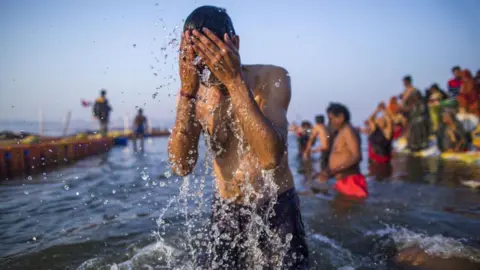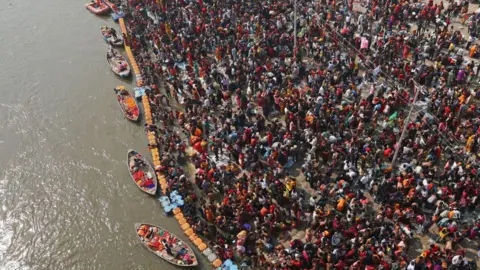No faecal bacteria in Kumbh Mela river waters, says minister
 Getty Images
Getty ImagesThe chief minister of India's Uttar Pradesh state has rejected a government report that found high levels of contamination in a key bathing place at the Kumbh Mela, the world's largest gathering.
The report said the waters at Sangam - the confluence of rivers considered holy by Hindus - in Prayagraj city had alarming levels of untreated sewage and bacteria found in human and animal excreta, making it unfit for bathing.
On Wednesday, Chief Minister Yogi Adityanath insisted that the water was not just fit for bathing, but also safe for doing aachman - the Hindu ritual of drinking a handful after bathing.
Authorities say 565 million have bathed since the festival began on 13 January.
 Getty Images
Getty ImagesThe Kumbh Mela (also known as Mahakumbh) - is held once every 12 years.
Hindus believe that taking a dip at Sangam - the confluence of India's most sacred Ganges river with the Yamuna river and the mythical Saraswati - will cleanse them of sins, purify their soul and help them attain salvation.
The Mela, which stretches over six weeks, draws devotees from all walks of life and from all around the world. Tens of millions have been bathing in the rivers daily during the festival, which will end on 26 February.
However, health activists and environmentalists have expressed concern over the water quality of the rivers during the festival.
Before the Mela began, India's top environment court had directed the pollution control boards of the federal and state governments to monitor the water in the rivers regularly and to take adequate steps to maintain its quality.
But a report submitted by the federal government's Central Pollution Control Board (CPCB) earlier this month stated that the waters of the Ganges and Yamuna had high coliform levels.
Coliform level is a key indicator of the presence of untreated sewage and faecal bacteria in water.
- Millions start bathing in holy rivers at India's biggest Hindu festival
- Thirty killed in crowd crush at India's Kumbh Mela festival
- What is Kumbh Mela and why is this Hindu festival important?
The report said that the coliform levels in the Ganges were 1,400 times more than the acceptable limit, and in the Yamuna river, they were 660 times more.
The CPCB analysed water samples from both the rivers on five separate days in January, but the coliform levels never met standards, the report added.
Chief Minister Adityanath, however, insisted that his government was continuously monitoring water in the rivers to maintain its quality.
"All the pipes and the drains in and around Sangam have been taped and the water is being released only after purification," he said.
"The reasons for increased faecal coliform can be several, such as sewage leakage and animal waste, but the amount of faecal coliform in Prayagraj is as per the standards," he added.
He accused the opposition of running a "false campaign" to defame the Kumbh Mela.
This is not the first time that the Uttar Pradesh government has come under scrutiny for the way it has organised and is managing the Kumbh Mela.
On one of the most auspicious bathing days in January, at least 30 people died in a crush that took place near the Sangam.
On Sunday, another crush at the New Delhi Railway Station - where thousands of devotees had gathered to board trains for Prayagraj - killed around 18 people.
